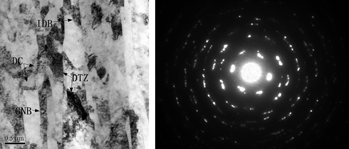Article contents
Microstructural evolution and thermal stability of 1050 commercial pure aluminum processed by high-strain-rate deformation
Published online by Cambridge University Press: 10 November 2015
Abstract

Microstructural and property evolution of 1050 commercial pure aluminum subjected to high-strain-rate deformation (1.2–2.3 × 103 s−1) by split Hopkinson pressure bar (SHPB) and subsequent annealing treatment were investigated. The as-deformed and their annealed samples at 373–523 K were characterized by transmission electron microscopy (TEM) and microhardness tests. TEM observations reveal that the as-deformed sample is mainly composed of a lamellar structure, whose transverse/longitudinal average subgrain/cell sizes are 293 and 694 nm, respectively. The initial coarse grains are refined significantly. The initial lamellar grain structures are subdivided into pancake-shaped subgrains due to a gradual transition by triple junction motion at 473 K, and then a dramatic microstructural coarsening is observed at 523 K. It is suggested that annealing behavior of this dynamic loading structure is better considered as a continuous process of grain coarsening or continuous recovery.
Keywords
- Type
- Articles
- Information
- Copyright
- Copyright © Materials Research Society 2015
References
REFERENCES
- 4
- Cited by




